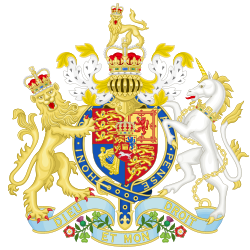| Act of Parliament | |
 | |
| Long title | An Act to empower His Majesty to secure and detain such Persons as His Majesty shall suspect are conspiring against His Person and Government. |
|---|---|
| Citation | 57 Geo. 3. c. 3 |
| Territorial extent | Great Britain |
| Dates | |
| Royal assent | 4 March 1817 |
| Commencement | 4 March 1817 |
| Expired | 1 July 1817 |
| Repealed | 5 August 1873 |
| Other legislation | |
| Amended by |
|
| Repealed by | Statute Law Revision Act 1873 |
Status: Repealed | |
| Text of statute as originally enacted | |
| Act of Parliament | |
 | |
| Long title | An Act to continue an Act to empower His Majesty to secure and detain such Persons as His Majesty shall suspect are conspiring against His Person and Government. |
|---|---|
| Citation | 57 Geo. 3. c. 55 |
| Territorial extent | Great Britain |
| Dates | |
| Royal assent | 30 June 1817 |
| Expired | 1 March 1818 |
| Other legislation | |
| Amends | Habeas Corpus Suspension Act 1817 57 Geo. 3. c. 3 |
| Repealed by | Habeas Corpus Suspension Act 1818 58 Geo. 3. c. 1 |
Status: Repealed | |
| Text of statute as originally enacted | |
| Act of Parliament | |
 | |
| Long title | An Act to repeal an Act made in the last Session of Parliament, intituled An Act to continue an Act to empower His Majesty to secure and detain such Persons as His Majesty shall suspect are conspiring against His Person and Government. |
|---|---|
| Citation | 58 Geo. 3. c. 1 |
| Dates | |
| Royal assent | 31 January 1818 |
| Commencement | 31 January 1818 |
| Other legislation | |
| Repeals/revokes |
|
| Repealed by | Statute Law Revision Act 1873 |
Status: Repealed | |
The Habeas Corpus Suspension Act 1817 (57 Geo. 3. c. 3) was an Act passed by the British Parliament.
Contents
The Home Secretary, Lord Sidmouth, introduced the second reading of the bill on 24 February 1817. In his speech he said there was "a traitorous conspiracy...for the purpose of overthrowing...the established government" and referred to "a malignant spirit which had brought such disgrace upon the domestic character of the people" and "had long prevailed in the country, but especially since the commencement of the French Revolution". This spirit belittled Britain's victories and exalted the prowess of her enemies and after the war had fomented discontent and encouraged violence: "An organised system has been established in every quarter, under the semblance of demanding parliamentary reform, but many of them, I am convinced, have that specious pretext in their mouths only, but revolution and rebellion in their hearts". [1]
The act was renewed later in the parliamentary session by the Habeas Corpus Suspension (No. 2) Act 1817 (57 Geo. 3. c. 55). [2] In autumn 1817 Sidmouth went through the list of all those detained under the Act and released as many as possible, personally interviewing most of the prisoners. He also tried to alleviate some of their conditions: "Solitary confinement will not be continued except under special circumstances". [2] The act was repealed in February 1818 by the Habeas Corpus Suspension Act 1818 (58 Geo. 3. c. 1). [3]